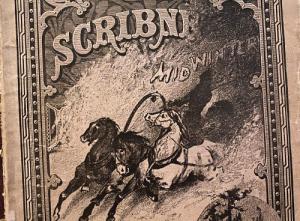February Birthdays
Wendell Willkie, the electricity industry's undisputed leader through the tumultuous 1930s as president of Commonwealth & Southern Corp., and the Republican Party's presidential candidate in 1940, was born on February 18, 1892 in Elwood, Indiana. More on Wendell, our most wondrous warrior for electricity and then the wider world, here.

Thomas Edison, the wizard of Menlo Park and the inventor of the electricity industry, literally, was born on February 11, 1847 in Milan, Ohio.
There are so many things we can say about Tom, our most terrific tinkerer. Here we'll tell you something you've probably not heard before.
Scribner's Magazine was famous in its day, as one of America's three major illustrated magazines in the late nineteenth century and early twentieth century, along with Harper's Monthly and The Atlantic Monthly. Scribner's was the first magazine with color illustrations. Its authors included Theodore Roosevelt, Edith Wharton, Ernest Hemingway, and the great muckraker Jacob Riis. Its artists included Frederic Remington and Howard Pyle, best known for his "Adventures of Robin Hood," and Leo Hershfield, best known for his sketches of the great courtroom trials of the twentieth century and the Senator McCarthy-Army censure hearings.
But before that famous magazine was founded, in January 1887, there was the literary periodical Scribner's Monthly published from 1870 to 1881. Right around the time Thomas Edison invented the incandescent light bulb.
The February 1880 issue of Scribner's Monthly was published only a month after the initial demonstration of the invention in Menlo Park, on the thirty-first of December. In that issue, Edison's mathematician, Francis Upton, provides "the first correct and authoritative account of my invention of the Electric Light," according to Edison.
This historic issue is one of the most prized documents in the archives of Public Utilities Fortnightly. Let's take a look at Upton's remarkable fourteen page article, with his fifteen detailed drawings of the electricity industry's birth.
In the article's opening paragraph, Upton reflects on Edison's try-everything-and-anything method. "The contrivances of the new lamp are so absurdly simple as to seem almost an anti-climax to the laborious process of investigation by which they have been reached."
Upton also notes what at the time was a crucial breakthrough. "The difficulty of subdivision Mr. Edison has also overcome: in his method of illumination a number of separate lights can now be supplied from the same wire, and each one, being independent, can be lighted or extinguished without affecting those near it." Thank goodness for independently-controllable electrical devices on a single circuit!
In the next three pages, Upton gives us an insightful analysis of the history of innovation in electricity and illumination to date, to 1880. Edison and his team clearly thought through quite thoroughly the trials and developments preceding them. Their goal was certain, to invent a light that was economical, safe and what we'd now call user-friendly, so that their illumination device would be eagerly adopted and used universally.
"Mr. Edison's idea in regard to the electric light was that, in all respects, it should take the place of gas." As we are, in our present day, electrifying usages of energy that have heretofore involved the combustion of fuels, the Menlo Park wizard's mission was exactly that: to electrify the usage of energy for illumination that had involved fuel combustion. For sure, Edison would have totally enjoyed attending this April's Electrification 2020 giga-conference in Charlotte.
The concept of a central station to generate the electricity to power the lights for miles around was also introduced in Upton's article, and sketched in the article's figure 11. It would be two and a half years until Edison's Pearl Street Station went into operation in lower Manhattan as the world's first power plant for distributing electricity.
Upton was a bit optimistic. "It is proposed to establish such stations in the course of a few months in the heart of several of our large cities."
Upton's article keeps going, and actually outlines electric distribution grids. "These lines of wires will start from the central station and send out branches in the same manner that gas or water pipes diverge, growing smaller the farther that are removed from the central station." Evidently, Edison and his team had already figured out the essential components like customer meters, illustrated in figure 13, and lamp switches. And they had already conceptualized a number of electric appliances aside from lights, including electric sewing machines and electric elevators.
Within just a few years of this historic article, the first era of electrification spurred by Edison would sweep the country and the world. And in the hundred and forty years since 1880, Edison's successors have brought to our society uncountable beneficial electric machines, appliances and devices.
Yet, even after a hundred and forty years, electricity is the energy for just a fifth of our equipment. Fuel combustion does the overwhelming proportion of our work, still, from transportation to heating of buildings to industrial processes.
So how appropriate is it that this special issue of Public Utilities Fortnightly on electrification — and on the upcoming Electrification 2020 — also honors the founding father of electrification, Thomas Edison? He spurred electrification to this point. Perhaps our warm memories of the terrific tinkerer will spur electrification from this point onward.



